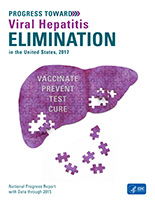2020 National Viral Hepatitis Progress Report
The Centers for Disease Control and Prevention (CDC) strives to prevent viral hepatitis infections and eliminate disease and mortality caused by viral hepatitis. The National Viral Hepatitis Progress Report provides information on progress in the implementation of recommended interventions and the impact these interventions are having on prevention of viral hepatitis transmission, disease, and associated mortality. This year, CDC modified the goals and associated targets from previous reports to align them with CDC’s Division of Viral Hepatitis 2025 Strategic Plan [PDF – 3 MB].
Report At-A-Glance
Ten indicators provide an objective way to assess progress toward achieving key viral hepatitis goals. Select the indicator from the table below for more information.
| Baseline 2017 data year |
2018 Observed (Annual Target*) |
2025 Goal 2023 data year |
Status | |
|---|---|---|---|---|
| Reduce estimated† new hepatitis A virus infections by ≥40% | 6,700 | 24,900 (6,250) |
4,000 | |
| Reduce estimated† new hepatitis B virus infections by ≥20% | 22,200 | 21,600 (21,500) |
18,000 | |
| Reduce reported rate‡ of new hepatitis B virus infections among persons who inject drugs¶ by ≥25% | 1.4 | 1.2 (1.3) |
1.0 | |
| Reduce reported rate‡of hepatitis B-related deaths by ≥20% | 0.46 | 0.43 (0.45) |
0.37 | |
| Reduce reported rate‡ of hepatitis B-related deaths among Asian and Pacific Islander persons by ≥25% | 2.45 | 2.10 (2.35) |
1.84 | |
| Reduce estimated† new hepatitis C virus infections by ≥20% | 44,700 | 50,300 (43,083) |
35,000 | |
| Reduce reported rate‡ of new hepatitis C virus infections among persons who inject drugs¶ by ≥25% | 2.3 | 2.6 (2.2) |
1.7 | |
| Reduce reported rate‡ of hepatitis C-related deaths by ≥20% | 4.13 | 3.72 (3.94) |
3.00 | |
| Reduce reported rate‡ of hepatitis C-related deaths among American Indian and Alaska Native persons by ≥30% | 10.24 | 9.05 (9.73) |
7.17 | |
| Reduce reported rate‡ of hepatitis C-related deaths among non-Hispanic Black persons by ≥30% | 7.03 | 6.31 (6.68) |
4.92 | |
| *Annual targets assume a constant (linear) rate of change from the observed baseline (2017) to the 2025 goal (2023 data year). †The number of estimated viral hepatitis infections was determined by multiplying the number of reported cases by a factor that adjusted for under-ascertainment and under-reporting (CDC 2018 Surveillance Summary and Klevens, et al, 2014). ‡Per 100,000 U.S. population. ¶Persons aged 18–40 years serve as a proxy for persons who inject drugs. |
||||
 Met or exceeded current annual target Met or exceeded current annual target |
 Moving toward annual target, but annual target was not fully met Moving toward annual target, but annual target was not fully met |
 Annual target was not met and has not changed or moved away from annual target Annual target was not met and has not changed or moved away from annual target |
The ten indicators and accompanying 2025 goals compiled specifically for the National Progress Report are consistent with the CDC’s Division of Viral Hepatitis 2025 Strategic Plan [PDF – 3 MB].
- The large increase in hepatitis A for 2018 is associated with ongoing, widespread person-to-person outbreaks. These outbreaks are occurring among high-risk adults and demonstrate the importance of vaccination as well as public health surveillance to identify and respond to outbreaks of hepatitis A.
- Only minimal progress is being made in reducing the incidence of new hepatitis B virus infections overall. However, new infections among people who inject drugs (PWID) and among Asians and Pacific Islanders have decreased, along with hepatitis B-related deaths overall. Continued efforts to increase infant and at-risk adult vaccination rates and improve appropriate testing and linkage to care are needed.
- Of great concern are the ongoing and apparent large increases in the incidence of hepatitis C virus (HCV) infections. The lack of a hepatitis C vaccine and increases in injection-drug use related to the nation’s opioid crisis have contributed to these increases in acute hepatitis C. Efforts to curb HCV transmission and identify all new (acute) and existing (chronic) infections must continue to improve access to well-tolerated, short-course treatments that can cure almost all HCV-infected persons.
- Like hepatitis B, the nation continues to make progress towards reducing deaths related to hepatitis C; however, continued efforts are needed to identify new and chronic infections and ensure that all people with viremia, including PWID, receive curative therapy.
Annual Reports of Progress Toward 2020 Goals
2019 National Viral Hepatitis Progress Report – published in 2019 and included data through 2017.
2018 National Viral Hepatitis Progress Report – published in 2018 and included data through 2016.
Inaugural Report
Progress Toward Viral Hepatitis Elimination in the United States [PDF – 46 pages] was the inaugural report published in 2017 that included data through 2015. The comprehensive report highlighted the nation’s progress at the time toward reducing the burden of hepatitis A, hepatitis B, and hepatitis C.
